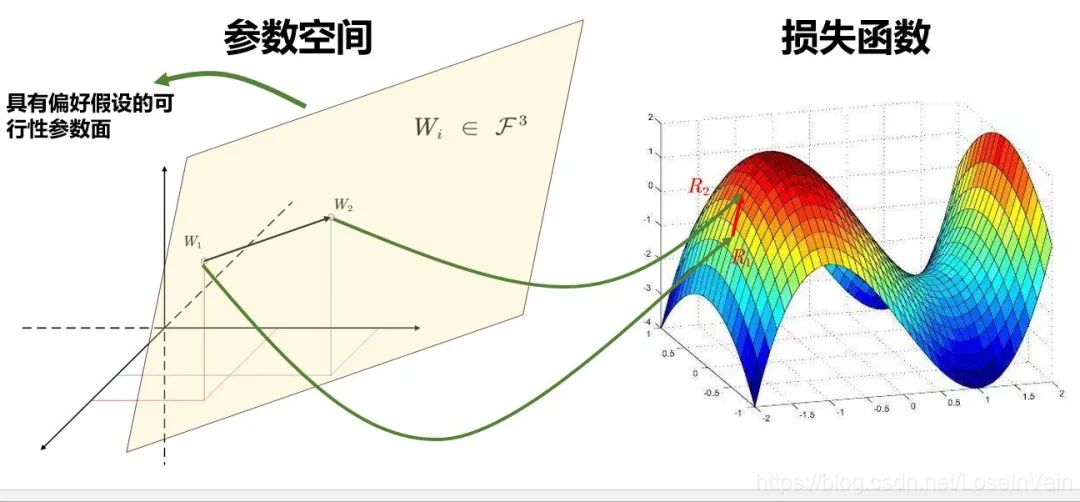收藏 | Pytorch 常用损失函数拆解
Posted 人工智能博士
tags:
篇首语:本文由小常识网(cha138.com)小编为大家整理,主要介绍了收藏 | Pytorch 常用损失函数拆解相关的知识,希望对你有一定的参考价值。
点上方人工智能算法与Python大数据获取更多干货
在右上方 ··· 设为星标 ★,第一时间获取资源
仅做学术分享,如有侵权,联系删除
转载于 :作者 | 小新 ,编辑 | 极市平台 来源 | https://lhyxx.top

本文从理论和实践两方面来全面梳理一下常用的损失函数。(避免自己总是一瓶子不满半瓶子晃荡……)。要么理论满分,编码时不会用;要么编码是会调包,但是不明白其中的计算原理。本文来科普一下。
我们将每个损失函数分别从理论和pytorch中的实现两个方面来拆解一下。
另外,解释一下torch.nn.Module 和 torch.nn.functional(俗称F)中损失函数的区别。
Module的损失函数例如CrossEntropyLoss、NLLLoss等是封装之后的损失函数类,是一个类,因此其中的变量可以自动维护。经常是对F中的函数的封装。而F中的损失函数只是单纯的函数。
当然我们也可以自己构造自己的损失函数对象。有时候损失函数并不需要太复杂,没有必要特意封装一个类,直接调用F中的函数也是可以的。使用哪种看具体实现需求而定。
CrossEntropyLoss
交叉熵损失,是分类任务中最常用的一个损失函数。
理论
直接上理论公式:
其中 是真实标签, 是预测的类分布(通常是使用softmax将模 型输出转换为概率分布), 也就是 与 中的元素分别表示对应类 别的概率。
举个例子,清晰明了:
# 假设该样本属于第二类 # 因为是分布, 所以属于各个类的和为 1
pytorch-实现
from torch.nn import CrossEntropyLoss举例:
实际使用中需要注意几点:
torch.nn.CrossEntropyLoss(input, target)中的标签target使用的不是one-hot形式,而是类别的序号。形如target = [1, 3, 2]表示3个样本分别属于第1类、第3类、第2类。torch.nn.CrossEntropyLoss(input, target)的input是没有归一化的每个类的得分,而不是softmax之后的分布。
举例,输入的形式大概就像相面这种格式:
然后就将他们扔到CrossEntropyLoss函数中,就可以得到损失。
loss = CrossEntropyLoss(input, target)我们看CrossEntropyLoss函数里面的实现,是下面这样子的:
def forward(self, input, target):
return F.cross_entropy(input, target, weight=self.weight,
ignore_index=self.ignore_index, reduction=self.reduction)是调用的torch.nn.functional(俗称F)中的cross_entropy()函数。
参数
input:预测值,(batch,dim),这里dim就是要分类的总类别数
target:真实值,(batch),这里为啥是1维的?因为真实值并不是用one-hot形式表示,而是直接传类别id。
weight:指定权重,(dim),可选参数,可以给每个类指定一个权重。通常在训练数据中不同类别的样本数量差别较大时,可以使用权重来平衡。
ignore_index:指定忽略一个真实值,(int),也就是手动忽略一个真实值。
reduction:在[none, mean, sum]中选,string型。none表示不降维,返回和target相同形状;mean表示对一个batch的损失求均值;sum表示对一个batch的损失求和。
其中参数weight、ignore_index、reduction要在实例化CrossEntropyLoss对象时指定,例如:
loss = torch.nn.CrossEntropyLoss(reduction='none')我们再看一下F中的cross_entropy的实现:
return nll_loss(log_softmax(input, dim=1), target, weight, None, ignore_index, None, reduction)可以看到就是先调用log_softmax,再调用nll_loss。
log_softmax就是先softmax再取log:
nll_loss 是negative log likelihood loss:
详细介绍见下面torch.nn.NLLLoss,计算公式如下:
例如假设 , class ,则,class class
源码中给了个用法例子:
# input is of size N x C = 3 x 5
input = torch.randn(3, 5, requires_grad=True)
# each element in target has to have 0 <= value < C
target = torch.tensor([1, 0, 4])
output = F.nll_loss(F.log_softmax(input), target)
output.backward()因此,其实CrossEntropyLoss损失,就是softmax + log + nll_loss的集成。
CrossEntropyLoss(input, target) = nll_loss(log_softmax(input, dim=1), target)CrossEntropyLoss中的target必须是LongTensor类型。
实验如下:
pred = torch.FloatTensor([[2, 1], [1, 2]])
target = torch.LongTensor([1, 0])
loss_fun = nn.CrossEntropyLoss()
loss = loss_fun(pred, target)
print(loss) # 输出为tensor(1.3133)
loss2 = F.nll_loss(F.log_softmax(pred, dim=1), target)
print(loss2) # 输出为tensor(1.3133)数学形式就是:
torch-nn-BCELoss
理论
CrossEntropy损失函数适用于总共有N个类别的分类。当N=2时,即二分类任务,只需要判断是还是否的情况,就可以使用二分类交叉熵损失:BCELoss 二分类交叉熵损失。上公式 (y是真实标签,x是预测值):
其实这个函数就是CrossEntropyLoss的当类别数N=2时候的特例。因为类别数为2,属于第一类的概率为y,那么属于第二类的概率自然就是(1-y)。因此套用与CrossEntropy损失的计算方法,用对应的标签乘以对应的预测值再求和,就得到了最终的损失。
实践
torch.nn.BCELoss(x, y)x形状(batch,*),y形状与x相同。
x与y中每个元素,表示的是该维度上属于(或不属于)这个类的概率。
另外,pytorch中的BCELoss可以为每个类指定权重。通常,当训练数据中正例和反例的比例差别较大时,可以为其赋予不同的权重,weight的形状应该是一个一维的,元素的个数等于类别数。
实际使用如下例,计算BCELoss(pred, target):
pred = torch.FloatTensor([0.4, 0.1]) # 可以理解为第一个元素分类为是的概率为0.4,第二个元素分类为是的概率为0.1。
target = torch.FloatTensor([0.2, 0.8]) # 实际上第一个元素分类为是的概率为0.2,第二个元素分类为是的概率为0.8。
loss_fun = nn.BCELoss(reduction='mean') # reduction可选 none, sum, mean, batchmean
loss = loss_fun(pred, target)
print(loss) # tensor(1.2275)
a = -(0.2 * np.log(0.4) + 0.8 * np.log(0.6) + 0.8 * np.log(0.1) + 0.2 * np.log(0.9))/2
print(a) # 1.2275294114572126可以看到,计算BCELoss(pred,target)与上面理论中的公式一样。
内部实现
pytorch 中的torch.nn.BCELoss类,实际上就是调用了F.binary_cross_entropy(input, target, weight=self.weight, reduction=self.reduction)
torch.nn.BCEWithLogitsLoss
理论
该函数实际上与BCELoss相同,只是BCELoss的输入x,在输入之前需要先手动经过sigmoid激活函数映射到(0, 1)区间,而该函数将sigmoid与BCELoss整合到一起了。
也就是先将输入经过sigmoid函数,然后计算BCE损失。
实践
torch.nn.BCEWithLogitsLoss(x, y)x与y的形状要求与BCELoss相同。
pred = torch.FloatTensor([0.4, 0.1])
target = torch.FloatTensor([0.2, 0.8])
loss_fun = nn.BCEWithLogitsLoss(reduction='mean') # reduction可选 none, sum, mean, batchmean
loss = loss_fun(pred, target)
print(loss) # tensor(0.7487)
# 上面的过程与下面的过程结果相同
loss_fun = nn.BCELoss(reduction='mean') # reduction可选 none, sum, mean, batchmean
loss = loss_fun(torch.sigmoid(pred), target) # 先经过sigmoid,然后与target计算BCELoss
print(loss) # tensor(0.7487)可以看出,先对输入pred调用sigmoid,在调用BCELoss,结果就等于直接调用BCEWithLogitsLoss。
torch.nn.L1Loss
理论
L1损失很简单,公式如下:
x是预测值,y是真实值。
实践
torch.nn.L1Loss(x, y)x形状:任意形状
y形状:与输入形状相同
pred = torch.FloatTensor([[3, 1], [1, 0]])
target = torch.FloatTensor([[1, 0], [1, 0]])
loss_fun = nn.L1Loss()
loss = loss_fun(pred, target)
print(loss) # tensor(0.7500)其中L1Loss的内部实现为:
def forward(self, input, target):
return F.l1_loss(input, target, reduction=self.reduction)我们可以看到,其实还是对F.l1_loss的封装。
torch.nn.MSELoss
理论
L1Loss可以理解为向量的1-范数,MSE均方误差就可以理解为向量的2-范数,或矩阵的F-范数。
x是预测值,y是真实值。
实践
torch.nn.MSELoss(x, y)x任意形状,y与x形状相同。
pred = torch.FloatTensor([[3, 1], [1, 0]])
target = torch.FloatTensor([[1, 0], [1, 0]])
loss_fun = nn.MSELoss()
loss = loss_fun(pred, target)
print(loss) # tensor(1.2500)其中MSELoss内部实现为:
def forward(self, input, target):
return F.mse_loss(input, target, reduction=self.reduction)本质上是对F中mse_loss函数的封装。
torch.nn.NLLLoss
理论
NLLLoss(Negative Log Likelihood Loss),其数学表达形式为:
前面讲到CrossEntropyLoss中用的nll_loss,实际上,该损失函数就是对F.nll_loss的封装,功能也和nll_loss相同。
正如前面所说,先把输入x进行softmax,在进行log,再输入该函数中就是CrossEntropyLoss。
实践
torch.nn.NLLLoss(x, y)x是预测值,形状为(batch,dim)
y是真实值,形状为(batch)
形状要求与CrossEntropyLoss相同。
pred = torch.FloatTensor([[3, 1], [2, 4]])
target = torch.LongTensor([0, 1]) #target必须是Long型
loss_fun = nn.NLLLoss()
loss = loss_fun(pred, target)
print(loss) # tensor(-3.5000)其内部实现实际上就是调用了F.nll_loss():
def forward(self, input, target):
return F.nll_loss(input, target, weight=self.weight, ignore_index=self.ignore_index, reduction=self.reduction)torch.nn.KLDivLoss
理论
KL散度通常用来衡量两个连续分布之间的距离。两个分布越相似,KL散度越接近0。
KL散度又叫相对熵,具体理论可以参考:https://lhyxx.top/2019/09/15/%E4%BF%A1%E6%81%AF%E8%AE%BA%E5%9F%BA%E7%A1%80-%E7%86%B5/
注意,这里 x 与 y 都是分布,分布就意味着其中所有元素求和概率为1。
则:
本例中计算的 都是以e为底的。
实践
torch.nn.KLDivLoss(input, target)试验测试torch.nn.KLDivLoss,计算KL(pred|target):
pred = torch.FloatTensor([0.1, 0.2, 0.7])
target = torch.FloatTensor([0.5, 0.2, 0.3])
loss_fun = nn.KLDivLoss(reduction='sum') # reduction可选 none, sum, mean, batchmean
loss = loss_fun(target.log(), pred)
print(loss) # tensor(0.4322)
#上面的计算过程等价于下面
a = (0.1 * np.log(1/5) + 0.2 * np.log(1) + 0.7 * np.log(7/3))
print(a) # 0.43216input应该是log-probabilities,target是probabilities。input和target形状相同。
该函数是对F.kl_div(input, target, reduction=self.reduction)的封装。其原型为:torch.nn.functional.kl_div(input, target, size_average=None, reduce=None, reduction='mean')
注意,使用nn.KLDivLoss计算KL(pred|target)时,需要将pred和target调换位置,而且target需要先取对数:
loss_fun(target.log(), pred)---------♥---------
声明:本内容来源网络,版权属于原作者
图片来源网络,不代表本公众号立场。如有侵权,联系删除
AI博士私人微信,还有少量空位


点个在看支持一下吧

以上是关于收藏 | Pytorch 常用损失函数拆解的主要内容,如果未能解决你的问题,请参考以下文章
Pytorch常用的交叉熵损失函数CrossEntropyLoss()详解